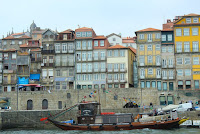 Berthing next to the 3000 people carrier "Queen Victoria", we feel a little dwarfed, but happy. None of us wants to be on such a steel monster. Fortunately they are about to finish their land operation, so we will not have to race against 25 tour busses. That would be a shame because Porto, once you reach the old part is idyllic and beautiful. Narrow streets, patina on the roofs, and the omnipresence of the river Douro with its slender traditional boats which - instead of Port wine casks - bring people from the bank of the river to the wineries.
Berthing next to the 3000 people carrier "Queen Victoria", we feel a little dwarfed, but happy. None of us wants to be on such a steel monster. Fortunately they are about to finish their land operation, so we will not have to race against 25 tour busses. That would be a shame because Porto, once you reach the old part is idyllic and beautiful. Narrow streets, patina on the roofs, and the omnipresence of the river Douro with its slender traditional boats which - instead of Port wine casks - bring people from the bank of the river to the wineries. So the city excursion was a full success, and who would forgo a nice tasting of tawny Port...?
In the meantime a smaller group set off for a brand-new excursion to explore the source of the river Douro and the source of that famous wine that made Portugal a very, very rich nation in the past. And like back then almost all the production is meant for export.


 A scenic bus ride brings us away from the buzzing city, deep into the hinterland of the Douro valley. The villages are nestled up against lush green hills that seem to never end, the buildings are hundreds of years old and seem to lean over to get a better view of the people passing by. Everything has a life of its own. No wonder people are very religious, and during our first stop in Amarante we hear an original story of Sao Gonçalo, the saint of the nearby church who was the protector of women. In general, but especially of young women who had a problem getting pregnant. So these women would come to the church and do things to the statue of Sao Gonçalo that would make a living man blush. I'll spare you the details, but apparently that worked: It is said that many of them succeeded. If not, they could always go to the local bakery and buy some of the traditional bread for their husband or fiancé. Decency forbids to show a picture of the bread here. Yes, you're guessing right... So the overall image is rather Pagan than Christian, and with this amusing information we carry on to our principal stop, Quinta da Pacheca, a vineyard overlooking the river Douro valley. A place of such a beauty that it enchants everybody on the spot.
A scenic bus ride brings us away from the buzzing city, deep into the hinterland of the Douro valley. The villages are nestled up against lush green hills that seem to never end, the buildings are hundreds of years old and seem to lean over to get a better view of the people passing by. Everything has a life of its own. No wonder people are very religious, and during our first stop in Amarante we hear an original story of Sao Gonçalo, the saint of the nearby church who was the protector of women. In general, but especially of young women who had a problem getting pregnant. So these women would come to the church and do things to the statue of Sao Gonçalo that would make a living man blush. I'll spare you the details, but apparently that worked: It is said that many of them succeeded. If not, they could always go to the local bakery and buy some of the traditional bread for their husband or fiancé. Decency forbids to show a picture of the bread here. Yes, you're guessing right... So the overall image is rather Pagan than Christian, and with this amusing information we carry on to our principal stop, Quinta da Pacheca, a vineyard overlooking the river Douro valley. A place of such a beauty that it enchants everybody on the spot.
 After a tour around the premises with their huge granite basins where the grapes are still picked by women only and tread by men with bare feet, the immense chestnut casks as big as a cabin by the lake and the vast fields of vines, we assemble at a stately table for a multi-course, home-made dinner with a variety of most delicate local dishes. Wine and Port included, of course. So when we finally have to get back to the bus, people move a little more heavily but with a satisfied grin.
After a tour around the premises with their huge granite basins where the grapes are still picked by women only and tread by men with bare feet, the immense chestnut casks as big as a cabin by the lake and the vast fields of vines, we assemble at a stately table for a multi-course, home-made dinner with a variety of most delicate local dishes. Wine and Port included, of course. So when we finally have to get back to the bus, people move a little more heavily but with a satisfied grin.A full hour takes us back, and more than one head is bobbing during the ride. We arrive just in time to board, and now we are out at sea, heading north again.




